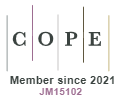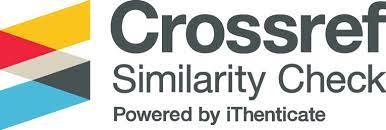Impact of Inflation, Markups and Wages on Changes in the Profitability of Enterprieses in Poland
DOI:
https://doi.org/10.18778/2391-6478.4.40.10Keywords:
profitability, markups, wages, inflation, Poland, VECMAbstract
The purpose of the study is to determine the impact of inflation, markups and wages on changes in the profitability of enterprises in Poland from 2008 to 2023, considering the effects in the short, medium and long term.
Methodology refers to the impact of CPI, markups and wages on changes in gross turnover profitability rates (GTPR) that were assessed using the VECM model, the impulse response function, and the variance decomposition.
Results of the research study show that the pillar of changes in the profitability of enterprises in Poland is its earlier changes with the increasing importance in the short term of markups, wages, and inflation (up to 10%) and gradually decreasing in the medium (up to 9%) and long term (7%). The importance of markups in the degree of explanation of changes in profitability is about 3–4 times stronger than that of wages. An increase in markups is an effective tool for stabilizing corporate profitability under inflation already in the short term, and can also be a tool to support an increase in such profitability in the medium and long term, if market conditions, including consumer demand, allow for it. The study fills a gap in the literature on the importance of markups and wages in shaping enterprises profitability in an inflationary condition, especially the use of markups as a tool that already produces expected effects in the short term.
Downloads
References
Bajgar M., G. Berlingieri S., Calligaris C., Criscuolo J. Timmis (2019), Industry Concentration in Europe and North America, Technical Report, OECD Publishing.
Google Scholar
Ball L. (1992), Why does hight inflation raise inflation uncertainty?, Journal of Monetary Economics, 29(3), pp. 371–388.
Google Scholar
DOI: https://doi.org/10.1016/0304-3932(92)90032-W
Ball L., Cecchetti S.G. (1990), Inflation and Uncertainty at Short and Long Horizon, Brooking Paper on Economic Activity, pp. 215–254.
Google Scholar
DOI: https://doi.org/10.2307/2534528
Barkai S. (2020), Declining Labour and Capital Shares, The Journal of Finance, pp. 2421–2463.
Google Scholar
DOI: https://doi.org/10.1111/jofi.12909
Boissay F., De Fiore F., Igan D., Tejada A.P., Rees D. (2022), Are major advanced economies on the verge of a wage-price spiral?, BIS Bulletin, https://www.bis.org/publ/bisbull53.pdf [Accessed: 12.12.2023].
Google Scholar
Caballero R.J., Farhi, E., Gourinchas, P.O. (2017), Rents, Technical Change and 17 Risk Premia Accounting for Secular Trends in Interest Rates, Returns on Capital, Earning Yields, and Factor Shares, American Economic Review, pp. 614–620.
Google Scholar
DOI: https://doi.org/10.1257/aer.p20171036
Calligaris S., Criscuolo C., Marcolin L. (2018), Mark-ups in the digital era. OECD Science, Technology and Industry Working Paper, OECD Publishing.
Google Scholar
Clements M.P., Galvão A.B. (2012), Measuring Macroeconomic Uncertainty: US Inflation and Output Growth, University of Reading, ICMA Center, Discussion Paper.
Google Scholar
CSO (2023), Central Statistical Office, Macroeconomic indicators, quarterly macroeconomic indicators, https://stat.gov.pl/wskazniki [Accessed: 12.12.2023].
Google Scholar
De Loecker J., Eeckhout J. (2018), Global Market Power, Working Paper 24768, National Bureau of Economic Research.
Google Scholar
DOI: https://doi.org/10.3386/w24768
Drechsler I., Savov A., Schnabl P. (2022), Credit Crunches and the Great Stagflation, https://pages.stern.nyu.edu/ [Accessed: 12.12.2023].
Google Scholar
Dudek M.K. (2008), About the problems of monetary policy differently (normally?), (O problemach polityki pieniężnej inaczej (normalnie?), Warszawa: Oficyna Wydawnicza SGH w Warszawie.
Google Scholar
Friedman M. (1959), The Demand for Money – Some Theoretical and Empirical Results, Journal of Political Economy.
Google Scholar
DOI: https://doi.org/10.1086/258194
Friedman M. (1970), A Theoretical Framework for Monetary Analysis, Journal of Political Economy.
Google Scholar
DOI: https://doi.org/10.1086/259623
Friedman M. (1977), Nobel Lecture: Inflation and Unemployment, Journal of Political Economy, pp. 451–472.
Google Scholar
DOI: https://doi.org/10.1086/260579
Friedman M. (1984), Lessons from the 1979-1982 Monetary Policy Experiment, American Economic Review.
Google Scholar
DOI: https://doi.org/10.3386/w1272
Glover A., Mustre-del-Rίo J., Ende-Becker A. (2023), How Much Have Record Corporate Profits Contributed to Recent Inflation, Economic Review, https://www.kansascityfed.org/research/economic-review/how-much-have-record-corporate-profits-contributed-to-recent-inflation/ [Accessed: 12.12.2023].
Google Scholar
DOI: https://doi.org/10.18651/ER/v108n1GloverMustredelRiovonEndeBecker
Goodhart C. A. E., Tsomocos D. P., Wang X (2023), Bank credit, inflation, and default risks over an infinite horizon, Journal of Financial Stability, Vol. 67, https://doi.org/10.1016/j.jfs.2023.101131
Google Scholar
DOI: https://doi.org/10.1016/j.jfs.2023.101131
Goodhart Ch., Peiris M. U., Tsomocos D. P., Wang, X. (2021), Corporate legacy debt, inflation, and the efficacy of monetary policy, CEPR Discussion Paper.
Google Scholar
Gradzewicz M., Mućk J. (2020), Unravelling the Markups Changes: The Role of Demand Elasticity and Concentration, NBP Working Paper, 334, pp. 1–28.
Google Scholar
Guti´errez G., Phillippon T. (2017), Investment less Growth: An Empirical Investigation, Brookings Papers on Economic Activity, pp. 89–169.
Google Scholar
DOI: https://doi.org/10.1353/eca.2017.0013
Hafer R.W., Heyne-Hafer G. (1981), The Relationship between Inflation and Expenditures of Proce Inflation and Its Variability: International Evidence from the 1970s, Journal of Macroeconomics, pp. 571–577.
Google Scholar
DOI: https://doi.org/10.1016/0164-0704(81)90085-9
Hall R.E. (2018), Using Empirical Marginal Cost to Measure Market Power in the US Economy, Working Paper 25251, National Bureau of Economic Research.
Google Scholar
DOI: https://doi.org/10.3386/w25251
Holland A.S. (1984), Dopes Higher Inflation lead to More Uncertain Inflation, Federal Reserve of St Louis.
Google Scholar
DOI: https://doi.org/10.20955/r.66.15-26.myq
IMF (2022), Wage Dynamic Post-Covid-19 and Wage-Price Spiral Risks, World Economic Outlook, Countering the Cost-Pf-Living Crises, pp. 51–69.
Google Scholar
Johansen S. (1991), Estimation and Hypothesis Testing of Cointegration Vectors in Gaussian Vector Autoregressive Models, Econometrica, No. 59.
Google Scholar
DOI: https://doi.org/10.2307/2938278
Johansen S. (1992), Determination of Cointegration Rank in the Presence of a Linear Trend, Oxford Bulletin of Economics and Statistics, No. 54.
Google Scholar
DOI: https://doi.org/10.1111/j.1468-0084.1992.tb00008.x
Johansen S. (1995), Likelihood-Based Inference in Cointegrated Vector Autoregressive Models, Oxford University Press.
Google Scholar
DOI: https://doi.org/10.1093/0198774508.001.0001
Joyce M. (1997), Inflation and inflation uncertainty, Bank of England Quarterly Bulletin.
Google Scholar
Keynes J.M. (1947), The General Theory of Employment, Interest and Money, https://link.springer.com [Accessed: 12.12.2023].
Google Scholar
Knight F.H. (1921), Risk, Uncertainty and Profit, University of Illinois at Urbana-Champagin1s Academy for Entrepreneurial Leadership Historical Research Reference in Entrepreneurship, http://ssrn.com/abstract=1496192 [Accessed: 12.12.2023].
Google Scholar
Koenigsberg O. (2022), 3 Strategic Options to Deal with Inflation, Harvard Business Review, https://hbr.org/2022/01/3-strategic-options [Accessed: 12.12.2023].
Google Scholar
Kosztowniak A. (2022), Wpływ Systemu Rezerwy Federalnej z Bretton Woods na politykę monetarną i bilanse płatnicze w gospodarce światowej na przełomie XX i XXI w., [w:] R. Bartkowiak, J. Ostaszewski, Z. Polański, System z Bretton Woods i jego dziedzictwo. Od pieniądza złotego do cyfrowego, Warszawa: Oficyna Wydawnicza SGH, pp. 183–210.
Google Scholar
Kufel T. (2011), Econometrics (Ekonometria), Warszawa: PWN.
Google Scholar
Logue D.E., Willett T.W. (1976), A note on the relation between the rate and variability of inflation, Economica, 43(170), pp.151–158.
Google Scholar
DOI: https://doi.org/10.2307/2553204
Modigliani F. (1977), The Monetarist Controversy or Should we Forsake Stabilization Policies? The American Economic Review.
Google Scholar
NBP (2023), Inflation and economic growth projection of the National Bank of Poland based on the NECMOD model (Projekcja inflacji i wzrostu gospodarczego Narodowego Banku Polskiego na podstawie modelu NECMOD), DAE.
Google Scholar
Piazzesi M., Schneider M. (2018), Payments, credit and asset prices, BIS Working Papers, 737.
Google Scholar
Reis R. (2022), The burs of high inflation in 2021-22: How and why did we get here? Lond School Econ, https://personal.lse.ac.uk/reisr/ [Accessed: 12.12.2023].
Google Scholar
Shannon C.E. (1948), A mathematical theory of communication, The Bell System Technical Journal, pp. 379–423.
Google Scholar
DOI: https://doi.org/10.1002/j.1538-7305.1948.tb01338.x
Syverson C. (2019), Macroeconomics and Market Power: Context, Implications, and Open Questions, Journal of Economic Perspectives, 33 (3), pp. 23–43.
Google Scholar
DOI: https://doi.org/10.1257/jep.33.3.23
Theil H. (1967), Economics and Information theory, Amsterdam: North-Holland Publishing Company.
Google Scholar
Downloads
Published
How to Cite
Issue
Section
License

This work is licensed under a Creative Commons Attribution-NonCommercial-NoDerivatives 4.0 International License.
Funding data
-
SGH Foundation
Grant numbers KZiF/S23:1.31














